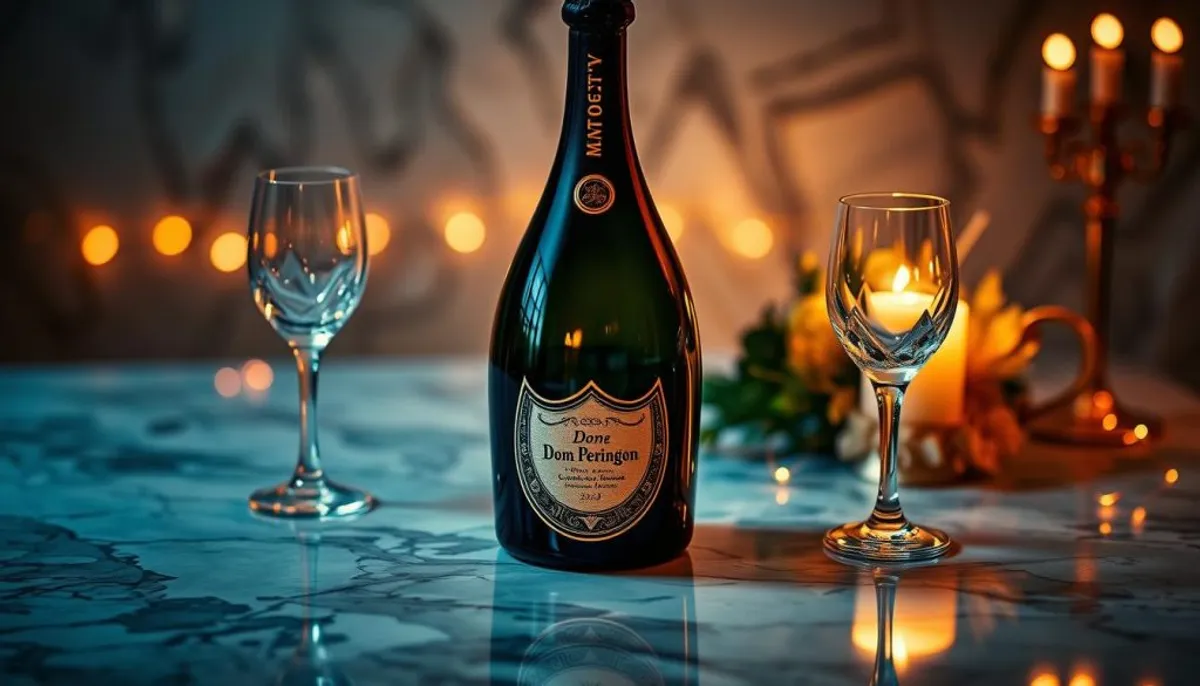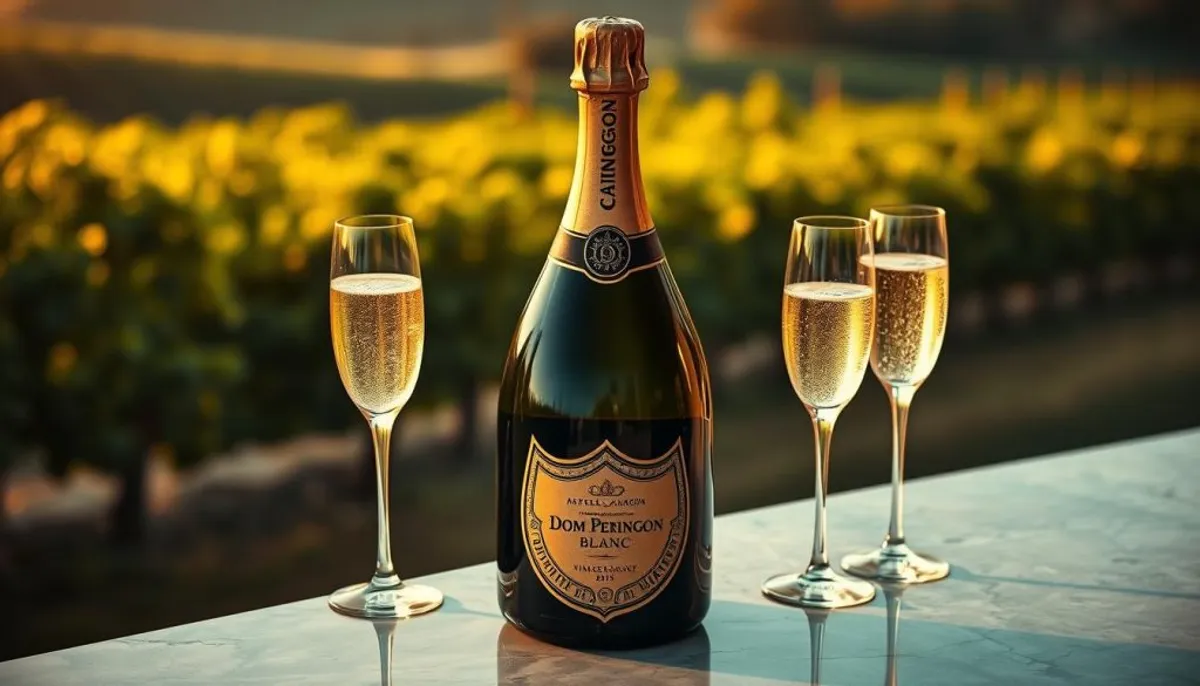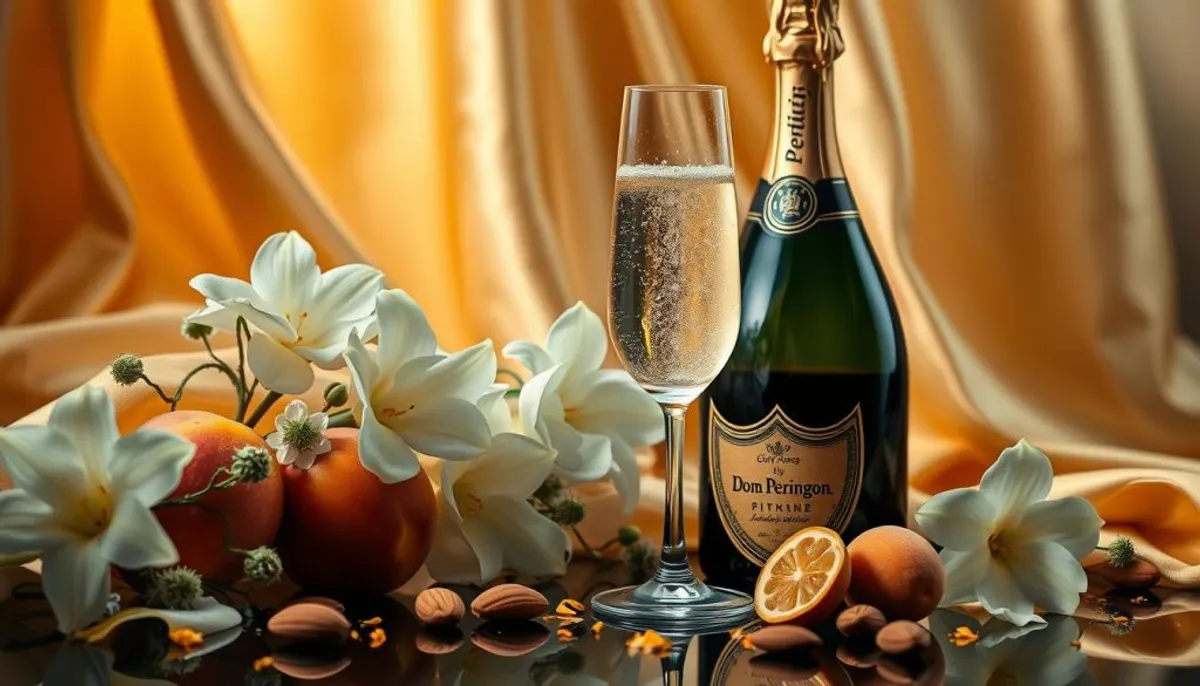Dom Perignon, the epitome of luxury champagne, shines as the crown jewel of Moet & Chandon. Since its introduction in 1921, it has enthralled champagne aficionados. This prestige cuvee is crafted only in the most exceptional years, showcasing the zenith of winemaking expertise.
The legacy of Dom Perignon traces back to Dom Pierre Pérignon, a 17th-century Benedictine monk. His groundbreaking innovations in champagne production are still celebrated today. Now, as part of the LVMH group, Dom Perignon continues to redefine the realm of vintage champagne.

Each Dom Perignon vintage narrates a unique tale, capturing the essence of a single growing season. The brand’s dedication to excellence is evident in its rigorous grape selection and aging process, which spans at least seven years.
For those aiming to elevate their cellar’s sophistication, Dom Perignon offers a variety of vintages for sale. From the refreshing Blanc to the delicate Rosé, every bottle guarantees an unmatched tasting experience.
Key Takeaways
- Dom Perignon produces only vintage champagne from exceptional years
- The brand’s history dates back to the 17th century
- Each vintage undergoes at least seven years of aging
- Dom Perignon offers both Blanc and Rosé varieties
- The champagne is known for its complexity and aging potential
- Limited editions and artist collaborations enhance its exclusivity
The Legacy of Dom Pierre Pérignon
Dom Pierre Pérignon’s influence on Champagne history is immense. As a Benedictine monk, he revolutionized winemaking at Hautvillers Abbey in the 17th century. His 47-year quest for perfection in sparkling wine established the groundwork for contemporary Champagne production.
The Benedictine Monk’s Vision
As cellarer of Hautvillers Abbey, Dom Pérignon envisioned a wine fit for royalty. His ambition to create such a wine sparked a winemaking transformation that resonated across centuries.
Revolutionary Winemaking Techniques
Dom Pérignon’s innovations in winemaking set new benchmarks. He pioneered grape blending from various vineyards, enriching the wine’s flavor profile. His technique of separate pressing ensured the wine’s clarity. Notably, he successfully produced white wine from red grapes, a technique still employed today.
From Abbey to Royal Courts
The monk’s creations soon attracted royal attention. Dom Pérignon’s sparkling wines adorned the tables of Louis XIV’s court, solidifying their status as luxury items. This royal endorsement cemented Champagne’s association with celebration and opulence.
Dom Pérignon’s legacy endures. The brand named after him continues to represent excellence in Champagne. From its origins in Hautvillers Abbey to its current global acclaim, Dom Pérignon encapsulates the intricate history of Champagne.
Dom Perignon For Sale: Exploring Current Vintage Collections
Dom Perignon vintages represent the zenith of luxury wine. This champagne collection showcases a variety of exceptional offerings, each embodying the essence of its unique growing season. Dom Perignon’s dedication to quality is evident, as it limits production to just six vintages per decade.
The current lineup boasts standout releases such as the Dom Pérignon Vintage 2010 and the Dom Perignon 2012. These wines undergo meticulous aging, resting for at least seven years before release. Some rare gems in the collection mature for up to 25 years, developing complex flavors and aromas.
Prices for Dom Perignon reflect its status in the luxury wine market. A standard 750ml bottle ranges from $250 to $400. Larger formats command higher prices, with 1.5L bottles fetching $800-$900 and 3L options reaching $2,500-$3,000. These prices underscore the exclusivity of Dom Perignon, which produces only about 1,500 cases annually.
Collectors and enthusiasts eagerly anticipate new releases. The Dom Perignon Lady Gaga Champagne, a creative collaboration, adds a touch of artistry to the champagne collection. For those seeking investment-worthy bottles, vintage years play a crucial role in determining value. Weather conditions during grape growth significantly impact quality and, consequentially, price.
With its rich history and commitment to excellence, Dom Perignon continues to set the standard for luxury champagne. Each bottle in the collection offers a unique taste of perfection, making it a prized addition to any wine cellar. The sparkling wine culture surrounding Dom Perignon enhances its allure, inviting enthusiasts to explore its legacy.
The Art of Vintage Champagne Making
Vintage champagne production is a meticulous process that demands expertise, patience, and unwavering dedication to quality. Dom Perignon, a pioneer in this art, has perfected its craft over decades, creating some of the world’s most coveted champagnes.
Exclusive Grape Selection Process
The journey of Dom Perignon begins with grape selection. Only the finest Chardonnay and Pinot Noir grapes from Grand Cru and Premier Cru vineyards make the cut. These grapes ripen slowly, developing complex flavors that form the foundation of Dom Perignon’s unique taste profile.
The Philosophy of Single-Year Vintages
Dom Perignon embraces the concept of single-year vintages, producing champagne only in exceptional years. This philosophy ensures that each bottle represents the best expression of a particular harvest. The 1961 vintage, for instance, featured a perfect 50-50 blend of Pinot Noir and Chardonnay, showcasing the brand’s commitment to balance and excellence.
Aging and Maturation Methods
Champagne aging is crucial to Dom Perignon’s distinctive character. Each vintage undergoes a minimum of seven years of maturation. The brand’s unique three-stage release system allows for extended aging:
- First release: After nine years
- P2 (Second Plenitude): 12-15 years
- P3 (Third Plenitude): 25 years
This prolonged aging on lees contributes to the wine’s depth, richness, and complexity, resulting in champagnes that maintain their freshness even after decades.
LVMH and Modern Dom Perignon Production
Dom Perignon, a name synonymous with luxury champagne, now thrives under the LVMH umbrella. This prestigious brand stands alongside other champagne giants like Krug, Ruinart, and Veuve Clicquot. LVMH’s acquisition has propelled Dom Perignon to new heights in champagne production and global recognition.
Vincent Chaperon, the current Chef de Cave, carries forward Dom Perignon’s legacy. He upholds the brand’s core values of hard work, intuition, and respect. Chaperon’s expertise ensures each vintage captures the unique character of its year while maintaining Dom Perignon’s signature style.
The brand’s commitment to excellence is evident in its production process. Dom Perignon sources grapes from top-tier vineyards in Champagne, blending Chardonnay and Pinot Noir in varying ratios. This meticulous selection results in champagnes that are both harmonious and emotionally evocative.
| Aspect | Detail |
|---|---|
| Grape Blend | Chardonnay and Pinot Noir (typically 50% each) |
| Vineyard Sources | Grand Cru and Premier Cru |
| Fermentation | Stainless steel tanks |
| Aging | Minimum 7 years before release |
| Annual Production | Estimated 5 million bottles |
Under LVMH’s guidance, Dom Perignon continues to innovate while honoring its rich history. The brand’s success is reflected in its market performance, with vintages like the 2010 Dom Perignon Brut seeing a 49% price increase in recent years. This blend of tradition and modernity ensures Dom Perignon remains a leader in luxury champagne production.
Understanding Dom Perignon’s Premium Pricing
Dom Perignon’s luxury champagne prices are a reflection of its exclusive status and limited production. The brand’s commitment to excellence and unique winemaking processes contribute to its premium positioning in the market.
Factors Influencing Cost
Several elements impact Dom Perignon’s pricing structure. The quality of the harvest, aging time, and rarity of the vintage play crucial roles. Dom Perignon Vintage spends at least seven years in the cellar before release, adding to its value. Rose varieties, produced only in exceptional years, command higher prices due to their scarcity.
Investment Potential
Dom Perignon presents a compelling wine investment opportunity. The brand’s reputation and limited annual production of about 5 million bottles maintain high demand among investors and enthusiasts. Vintage value appreciation is evident in recent market trends:
- The 1990 Dom Perignon Oenotheque Brut Millesime saw a 34% increase in value from 2021 to 2023
- The 1992 Dom Perignon P2 Plenitude Brut Rose experienced a remarkable 130% value increase in the same period
Vintage Value Comparison
Dom Perignon’s pricing varies significantly across vintages, reflecting their rarity and quality. Here’s a comparison of current market prices:
| Vintage | Type | Average Price |
|---|---|---|
| 2013 | Brut | $236 |
| 1988 | P3 Brut Rose | $5,373 |
| 1959 | Rose | $84,700 (Auction Price) |
These figures underscore Dom Perignon’s position as a premium champagne brand and its potential for substantial returns in the wine investment market. The consistent high scores from renowned wine critics further cement its status as a valuable collector’s item.
White and Rosé Collections
Dom Perignon’s White and Rosé Collections represent the zenith of vintage champagne artistry. With 23 distinct offerings, these collections epitomize luxury and elegance in every bottle.
Signature Blanc Vintages
The Dom Perignon Blanc range boasts 20 exquisite products, averaging €677.92 per bottle. These vintage champagnes, crafted from a blend of Chardonnay and Pinot Noir, present unique flavor profiles with each release. Among these, designer champagne bottles stand out, offering both elegance and sophistication. The crown jewel, the Dom Pérignon Plénitude P3 1992, commands an impressive €5,900.00.

Distinguished Rosé Offerings
The Dom Perignon Rosé collection, though smaller with just 3 products, is equally remarkable. The 2009 Dom Pérignon Rosé Champagne, priced at $485.00, exemplifies the collection’s quality. This vintage combines 56% Pinot Noir and 44% Chardonnay, aged for 13 years on lees. It has garnered high praise, with Wine Spectator awarding it 96 points.
Both collections offer significant investment potential, with prices ranging from €220.00 to €5,900.00. Five products boast ratings of 18.5 and above, with two achieving an exceptional 19.5 rating. These vintage champagnes represent the pinnacle of Dom Perignon’s winemaking expertise, offering unparalleled taste experiences for discerning palates.
The Three Plenitudes of Dom Perignon
Dom Perignon’s champagne aging process is a masterpiece of vintage maturation. The prestigious house releases its champagnes in three stages, known as Plenitudes. Each stage reveals a unique facet of the wine’s evolution, showcasing increasing depth and complexity.
The first Plenitude release occurs after about seven years of aging. This initial offering presents the wine’s youthful vibrancy and primary aromas. The Second Plenitude, or P2, emerges after 12-15 years. At this stage, the champagne displays heightened intensity and more complex flavors.
The Third Plenitude, P3, represents the pinnacle of Dom Perignon’s champagne aging. Released after 25 years, P3 showcases the most mature expression of the vintage. These Plenitude releases allow wine enthusiasts to experience the champagne’s transformation over time.
| Plenitude | Aging Time | Characteristics |
|---|---|---|
| First | 7 years | Youthful, vibrant, primary aromas |
| P2 | 12-15 years | Increased intensity, complex flavors |
| P3 | 25 years | Most mature expression, peak complexity |
Dom Perignon’s commitment to excellence is evident in their vintage maturation process. The house produces a maximum of six vintages per decade, ensuring each release meets their exacting standards. This meticulous approach to champagne aging results in wines of exceptional quality and character.
Limited Edition Collaborations and Artist Series
Dom Perignon’s limited edition champagnes showcase the brand’s dedication to artistry and innovation. These bottles merge luxury with creativity, creating unique pieces that appeal to both champagne aficionados and art enthusiasts. This blend of luxury and creativity results in a collection that stands out.
Designer Partnerships
The champagne house collaborates with celebrated artists and designers to craft visually striking bottles. These collaborations, including an exclusive champagne collaboration, elevate the Dom Perignon experience through their stunning packaging. For instance, the partnership with Lady Gaga resulted in a limited edition sculpture for the Dom Pérignon Rosé Vintage 2005, available in only 110 pieces.
Collectible Releases
Dom Perignon’s collectible releases often celebrate major milestones or introduce groundbreaking designs. These special editions quickly gain popularity among collectors. The brand’s commitment to creativity is evident in its innovative packaging, such as glow-in-the-dark labels and gold bottles, like the Dom Perignon Rosé Vintage Gold Bottle 2000.
Special Edition Packaging
The packaging of these limited edition champagnes is a masterpiece in itself. From opulent gift boxes to uniquely shaped bottles, each release is crafted to be a centerpiece. These special editions boast intricate details and premium materials, making them ideal for gifting or display. A stunning champagne display can elevate any occasion, showcasing the elegance of these exquisite bottles.
| Collaboration | Year | Special Feature |
|---|---|---|
| Lady Gaga | 2021 | Exclusive sculpture for Rosé Vintage 2005 |
| Bvlgari | 2020 | Luxurious gift box design |
| Lenny Kravitz | 2019 | Unique candelabra bottle holder |
Tasting Notes and Food Pairing

Dom Perignon’s flavors are a sensory delight, with each sip offering a unique experience. The Blanc vintage presents a harmonious blend of almond, cocoa, and white fruit aromas. On the palate, dried flowers mingle with toasted notes and a hint of spice, culminating in a satisfying finish. The Rosé vintage, on the other hand, is characterized by ripe fruit, figs, roasted apricots, and confit orange, creating a symphony of flavors.
Champagne tasting unveils the true essence of Dom Perignon. The P2 and P3 releases are notable for their increased intensity and complexity, appealing to connoisseurs. With an alcohol content of 12.5%, this champagne is a perfect match for a variety of cuisines, enhancing any dining experience.
Food pairing is an art form when it comes to Dom Perignon. Here are some exquisite combinations to consider:
- Salmon or tuna
- Shellfish and lobster
- Beluga caviar
- Pork dishes
- Rich cheese platters
The Rosé vintage is robust enough to stand up to bold flavors and textures, making it ideal for adventurous pairings. For a truly indulgent experience, pair Dom Perignon with delicate pastries or light poultry dishes.
Wine critics have consistently praised Dom Perignon. James Suckling awarded it 98 points, while Wine Enthusiast and Wine Spectator both gave it 96 points. Its aging potential of 10-20 years solidifies its status as a celebratory champagne, perfect for marking special occasions and milestones for years to come.
Storage and Serving Recommendations
Ensuring the right storage and serving techniques, including proper champagne uncorking techniques, is crucial for fully appreciating Dom Perignon. We will examine the essential practices for maintaining and presenting this luxurious champagne.
Optimal Temperature Control
Dom Perignon should be stored at temperatures ranging from 45-65°F (7-18°C). This temperature range is ideal for preserving the champagne’s quality. It is also important to maintain humidity levels above 70% to keep the cork in good condition and slow down the aging process. When stored correctly, unopened bottles can last for 7-10 years.
Proper Glass Selection
Opt for the appropriate wine glasses to elevate your Dom Perignon experience. Tulip-shaped flutes are the best choice, as they help preserve the bubbles and concentrate the aromas. When serving, aim to chill the champagne to 46-50°F (8-10°C) for the best flavor and effervescence.
Aging Potential Guidelines
Dom Perignon has three peak stages of maturity:
- P1: Around 9 years after vintage
- P2: After 20 years
- P3: Between 30-40 years
Each stage offers distinct flavors and complexities. Once opened, it is best to enjoy the champagne within five days for the optimal taste. Using a champagne sealer can help preserve leftover wine and maintain its quality.
By adhering to these guidelines for champagne storage, serving temperature, and wine glass selection, you will enhance your Dom Perignon experience. This will allow you to fully appreciate its exceptional qualities.
Conclusion
Dom Perignon is a cornerstone in the realm of luxury champagne, showcasing unparalleled winemaking prowess. Since its creation in 1668, it has elevated champagne artistry to new heights. The cost of recent Dom Perignon vintages, averaging €215, underscores its elite status. Rare vintages, on the other hand, can reach up to €500 per bottle, highlighting their rarity and value. Additionally, the exclusive champagne collaboration with renowned brands has further enhanced its prestige.
The brand’s dedication to vintage-only production distinguishes it in the fine wine world. Dom Perignon vintages undergo a rigorous aging process, “sur latte,” for at least seven years. This commitment to quality is reflected in the Robert Parker scores, with the 1996 and 1990 Millésimes scoring an impressive 98/100. The 2008 vintage also received a 96+ rating, demonstrating the brand’s consistent excellence.
Dom Perignon has also ventured into rosé versions and the exclusive Plénitude series. These offerings, along with collaborations with renowned artists, have cemented its status as a highly sought-after champagne investment. Whether for special occasions or as a prized collection, Dom Perignon continues to enchant wine aficionados globally. It offers a unique blend of champagne mastery, transcending time and trends.
RelatedRelated articles



